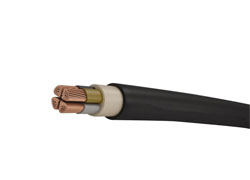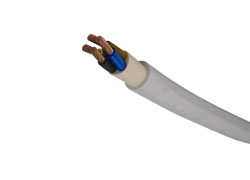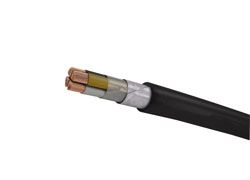1. The difference between cables and wires
In fact, there is no strict boundary between "wire" and "cable". Usually, the product with a small number of cores, a small product diameter, and a simple structure is called a wire. A wire without insulation is called a bare wire. Others are called cables. A conductor with a larger cross-sectional area (greater than 6 mm2) is called a large wire. Small (less than or equal to 6 mm2) is called a small wire, and an insulated wire is also called a cloth wire.
The wires are made up of one or more flexible wires with a light and soft sheath; the cable is made up of one or more insulated sheathed wires and covered with a tough outer layer made of metal or rubber. Cables and wires are generally composed of three components: a core wire, an insulating sheath, and a protective sheath.
Where is the difference between cables and wires, optical cables, and optical fibers?
The characteristics of commonly used cables are as follows:
CEF - Ethylene propylene rubber insulated neoprene sheath, marine flame retardant power cable.
CVV - PVC insulated, PVC sheathed shipboard flame retardant power cable.
Oxygen tank wires often use BV, BX, RV, RVV series of wires, including: BV - copper-core PVC insulated wire, long-term allowable temperature 65 °C, minimum temperature -15 °C, working voltage AC 500V, DC 1000V, fixed laying In indoor and outdoor areas, it can also be used as a concealer.
BX - copper core rubber insulated wire, the maximum temperature of 65 °C, deposited in the room. RV—PVC insulated single-core cord, with a maximum operating temperature of 65°C, a minimum operating temperature of -15°C, a working voltage of 250V AC, and a 500V DC, used as internal wiring for instruments and equipment.
RVV - Copper core PVC insulated and sheathed flexible wire, allowing long-term operating temperature 105 °C, working voltage AC 500V, DC 1000V, for wet, high mechanical protection requirements, often moving and bending occasions. In fact, there is no strict boundary between "wire" and "cable".
Where is the difference between cables and wires, optical cables, and optical fibers?
Usually, the product with a small number of cores, a small product diameter, and a simple structure is called a wire. A wire without insulation is called a bare wire. Others are called cables. A conductor with a larger cross-sectional area (greater than 6 mm2) is called a large wire. Small (less than or equal to 6 square millimeters) is called a small wire. Insulated wire is also called a cloth wire. This is relatively simple and easy to understand!! The cable generally has more than 2 layers of insulation, most of which is a multi-core structure, wound around a cable tray. Above, the length is generally greater than 100 meters. Wire is generally single-layer insulation, single core, 100-meter roll, wireless disk.
Common type of cable: VV: PVC insulation (first V), PVC sheath (second V) YJV22: PVC insulation (YJ), PVC sheath (V) , Steel belt Kai (22) model plus "ZR" or "FR" for the flame-retardant cable (wire).
Adding "L" to the aluminum wire has a simpler model: BVV--PVC insulated and sheathed copper core wire, BV--PVC insulated copper core wire, BYJ--copper-core crosslinked polyolefin insulated wire, BVR--polyvinyl chloride insulated copper heart cord, BX--rubber insulated copper cord, RHF--neoprene rubber bushing copper cord.
Small diameter is called "line"; large diameter is called "cable".
The simple structure is called "line"; the structure is called "cable".
However, with the expansion of the scope of use, many varieties "cables in the line", "cables in the cable." Therefore, there is no need to make a strict distinction.
In everyday habits, people call household electrical wires as electrical wires, and power cables as cables.
Wire and cable include bare wires, winding wires, power cables, communication cables and optical cables, and electrical equipment.
2. Difference between cable and optical cable
Cable: When the phone converts the sound signal into an electrical signal, it is transmitted to the switch via the line. The switch then transmits the electrical signal directly to the other phone to answer the call. The cable used for this call is the cable. The main copper cable is copper wire. The diameter of the core wire is 0.32mm, 0.4mm and 0.5mm. The larger the diameter is, the stronger the communication ability is; and there are 5 pairs, 10 pairs, 20 pairs, 50 pairs, 100 pairs, 200 points according to the number of core wires. For example, the logarithm mentioned here refers to the maximum number of users that can be accommodated in the cable; there are also points by package, which I do not quite understand.
Cable: Its size, weight, and poor communication capabilities can only be used for short-range communications.
Optical cable: When the phone converts the acoustic signal into an electrical signal, it is transmitted to the switch via the line. The switch then transmits this electrical signal to the photoelectric conversion device (converts the electrical signal into an optical signal) via the line to another photoelectric conversion device ( The optical signal is converted into an electrical signal), then to the switching equipment, to another telephone. The line between the two photoelectric conversion devices is an optical cable. It is said that it has only the number of cores, the number of cores: 4, 6, 8, 12 pairs and so on.
Optical fiber cable: Its advantages include small size, light weight, low cost, large communication capacity, and strong communication capability.
Due to many factors, it is currently used only as a communication between long-distance and point-to-point (ie two switch rooms). The difference between them is that the inside of the cable is a copper wire; the inside of the cable is glass fiber.
Optical fiber communication cable is a certain number of optical fibers in accordance with a certain way to form a cable core, outsourcing jacket, and some also cover the outer jacket, to achieve a kind of optical signal transmission line. Field trials have been conducted in Shanghai, Beijing, Wuhan and other places. Shortly afterwards, it was used as an inter-office trunk within the city's telephone network. Since 1984, it was gradually used for long-distance lines and began to use single-mode optical fibers. The communication cable has a larger transmission capacity than the copper cable. The hop distance is long, the volume is small, the weight is light, and there is no electromagnetic interference. Since 1976, the trunk line, city relay, offshore and transoceanic communication have been developed. As well as the backbones of wired transmission lines such as local area networks and private networks, they began to develop the field of urban users' loop distribution networks, and provided transmission lines for fiber-to-the-home and broadband-generation integrated service digital networks.
A cable is usually a rope-like cable twisted from several or several sets of conductors (at least two in each group). Each set of conductors is insulated from one another and often twists around a center. The entire external bread has a height. Insulative coating; especially the first submarine cable: there is a difference in material. The cable is made of metal material (mostly copper and aluminum); the fiber optic cable is made of vitreous fiber. Second: There is a difference in the transmission signal. Cables transmit electrical signals. Optical cables transmit optical signals. Third: There is a difference in the scope of application. Cables are now used for energy transmission and low-end data transmission (such as telephone). Optical fiber cable is mostly used for data transmission.
3 cable and optical fiber difference
Cables are generally considered to be made up of one or more insulated conductors that are insulated and protected by layers of conductors that carry electricity or information from one place to another. Broadly speaking, it refers to a device that uses metal as a medium to transmit electrical signals.
By definition, the cable is used to conduct electricity. Generally made of the following metals:
Copper conductivity is second only to silver, thermal conductivity is second only to gold and silver, corrosion resistance, non-magnetic, good plasticity, easy to weld, and versatile. Copper alloys mainly improve the wear resistance, corrosion resistance and mechanical and physical properties of copper.
Silver, metal has the highest conductivity and thermal conductivity, has good corrosion resistance and oxidation resistance, and is easy to weld; it is mainly used for coating and cladding;
Gold, nickel, used as high temperature line.
Iron (steel) is often used as a reinforcing material for composite conductors, such as steel-core aluminum wire, copper-clad steel, and aluminum-clad steel wire.
Zinc, used as a coating for wire/steel strip/iron conductors, to prevent corrosion.
Tin, used as a wire/copper wire coating, is used to prevent corrosion and facilitate the welding of copper wire.
Henan Sanheng Cable Co., Ltd , founded in 2000, It is one of the top wire and cable manufacturers in China's wire and cable industry for nearly 20 years. the company has more than 5 production lines.
The production cable can be divided into more than 50 varieties and subdivided into 1000 specifications.All products have passed national certification, such as China compulsory certification, bv certification, Nigerian SONCAP certificate, China national industrial certification, etc. China national industrial production license, etc.It also has the ability to produce products that meet international standards, such as iec, ce, rohs, etc.
If you want to buy wires and cables, you can ask the customer service staff and we will get back to you as soon as possible.
-

600 1000V CU XLPE Power Cable
Conductor:Bare Copper Conductor of Class 1/2 (Solid)
Insulation:XLPE Compound
Insulation Color:Red, Blue, Grey, Yellow/Green or as request
-

600-1000V AL XLPE Power Cable
3500 V:Bare Aluminum Conductor of Class 1/2 (Solid)
Insulation:XLPE Compound
Insulation Color:Red, Blue, Grey, Yellow/Green or as request
-

600-1000V Flexible Power Cable
Conductor:Bare Copper Conductor of Class 5 (Flexible)
Insulation:PVC Compound
Insulation Color:Red, Blue, Grey, Yellow/Green or as request
-

600-1000V SWA Armoured Cable
Conductor:Bare Copper Conductor of Class 1/2 (Solid)
Insulation:XLPE Compound
Insulation Color:Red, Blue, Grey, Yellow/Green or as request





